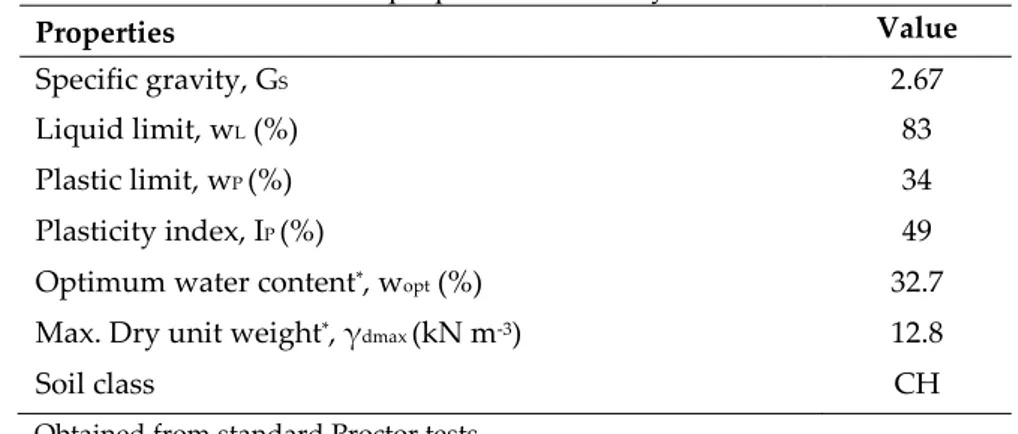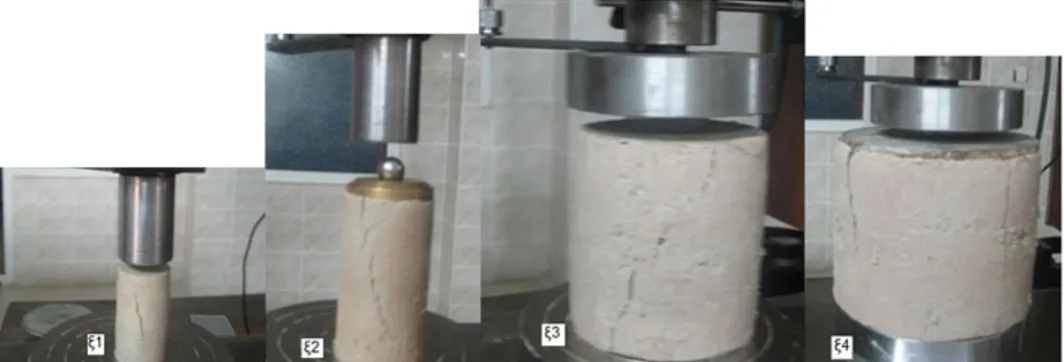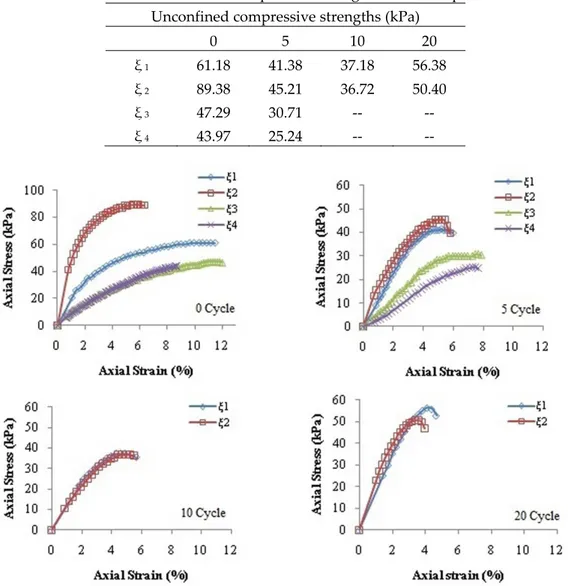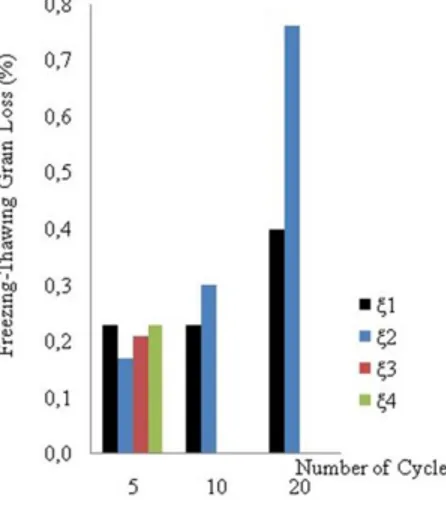EFFECT OF ASPECT RATIO ON THE FREEZING-THAWING OF A CH CLAY
1,*R. Kağan AKBULUT, 2A. Şahin ZAİMOĞLU
1,*Atatürk University, Technical Vocational School of Higher Education, Department of Construction, 25240 Erzurum / TURKEY
2Atatürk University, Faculty of Engineering, Department of Civil Engineering, 25240 Erzurum / TURKEY
1,*rkakbulut@atauni.edu.tr, 2zaimoglu@atauni.edu.tr
(Geliş/Received: 31.01.2018; Kabul/Accepted in Revised Form: 28.05.2018)
ABSTRACT: The geotechnical properties of fine grained soils which depends on the variation of aspect ratio (ξ=length/diameter) exposed to freezing-thawing is not known clearly. The effect of aspect ratio on unconfined compression strength and freezing-thawing resistance of fine grained soils after 0, 5, 10, and 20 freezing-thawing cycles have been investigated in this study. The freezing-thawing test was conducted in an automatic freezing-thawing cabinet, the freezing and thawing temperatures of which were selected as -20°C and +25°C, respectively. The unconfined compression test was conducted in an unconfined compression testing apparatus, the loading ratio of which was 0.8 mm/min. These values were held constant throughout the test. Tests were conducted on cylindrical samples with different ξ (length/diameter) ratios prepared at standard Proctor energy. The test results indicated that, as ξ ratio decrease and the number of freezing-thawing cycles increase, unconfined compression strength decrease and freezing-thawing grain loss increase.
Key Words: Aspect ratio, CH clay, Freezing-thawing, Unconfined compression strength
Numune Boyutunun CH Kilinin Donma-Çözülme Üzerindeki Etkisi
ÖZ: Donma-çözülmeye maruz zeminlerin davranışı numune boyutuna (ξ=boy/çap) bağlı olarak nasıl değişeceği tam olarak bilinmemektedir. Bu çalışmada numune boyutunun ince daneli zeminlerde 0, 5, 10 ve 20 donma-çözülme çevrim sonrası serbest basınç mukavemeti ve donma-çözülme dayanımı üzerindeki etkisi araştırılmıştır. Donma-çözülme deneyi donma sıcaklığı -20oC çözülme sıcaklığı +25oC
olan otomatik donma-çözülme kabininde, serbest basınç deneyi yükleme hızı 0.8 mm/dk olan serbest basınç deney aletinde yapılmıştır. Bu değerler deney sırasında sabit tutulmuştur. Deneyler standart proktor enerjisinde hazırlanmış farklı ξ (boy/çap) oranlarına sahip silindirik numuneler üzerinde yürütülmüştür. Deney sonuçlarından numunelerin ρ oranı ve donma-çözülme çevrim sayısının artmasıyla serbest basınç mukavemeti ile donma-çözülme dayanıklılığının azaldığı belirlenmiştir.
Anahtar Kelimeler: Boy/çap oranı, CH kil, Donma-çözülme, Serbest basınç dayanımı
INTRODUCTION
Foundation soils are exposed to freezing-thawing at least once a year in cold-climate regions. This phenomenon affects some engineering features of fine-grained soils, such as water content, bearing capacity, and permeability adversely. It is mentioned in the following references that freeze-thawing causes structural and volumetric changes in clayey soils (Wang et al., 2017; Wang et al., 2018; Xu et al., 2018; Lu et al., 2018). Andersland and Ladanyi (2004) indicated that freezing, thawing, and redistribution
of water in the ground during seasonal temperature changes are responsible for variations in soil properties and the behavior of foundation materials.
The depth to which these soil materials are affected requires prediction of the seasonal frost penetration (Andersland and Ladanyi, 2004). Therefore, studies regarding changes in geotechnical features of soils arising from freezing-thawing have taken part in literature prevalently in recent years (Yarbaşı et al., 2007; Altun et al., 2009; Zaimoğlu, 2010; Hazırbaba and Güllü, 2010; Ghazavi and Roustaie, 2010; Bello, 2011).
The aspect ratios used in these studies vary depending on either the preferred standards or particular preferences (Yazıcı and Sezer, 2007; Yarbaşı et al., 2007; An et al., 2008; Del Viso et al., 2008; Zaimoğlu, 2010; Hazırbaba and Güllü, 2010; Ghazavi and Roustaie, 2010).
The aspect ratios used in these studies vary depending on either the preferred standards or particular preferences (Yazıcı and Sezer, 2007; Yarbaşı et al., 2007; An et al., 2008; Del Viso et al., 2008; Zaimoğlu, 2010; Hazırbaba and Güllü, 2010; Ghazavi and Roustaie, 2010). The aspect ratio is supposed to affect some of the post-experimental determined geotechnical properties of soils. It has been stated in literature that, some of the determined engineering properties of concrete samples, such as unconfined compression resistance and durability, were significantly affected by aspect ratio (Yazıcı and Sezer, 2007; An et al., 2008; Del Viso et al., 2008). Additionally, Yalçın (2013) mentioned that the strength of sample decrease with increasing specimen size for the geometrically similar tested concrete samples. Yavuz et al., (2001) investigated the influence of sample size on the uniaxial compressive strength on the cubic shaped samples of different size for this purpose they used white marble and red travertine. Researchers reported that increasing specimen size is to cause significantly reduction of uniaxial compressive strength of rock and coal specimens. They are attributed this situation some studies (Hoek and Brown, 1980; Bieniawski, 1968; Swain, 1968; Kaczynski, 1986). Koç and Şener (2004) pointed out that stress decreases as the size increases on elements have a geometrically same but different size. The another study is conducted on concrete specimens of different sizes in Felekoğlu and Türkel (2005). Researchers stated “Due to the size effect, the relative strength of specimens varies at different dimensions” in their studies. Gök (2010) implied that the compressive strength increases while the sample size decreases. The researcher explained this increment in two theme: (1) Concrete surface in contact with the heads of the test press in small sample size is smaller than big ones. (2) Small-sized concrete samples’ cross sectional areas and volumes are also naturally small. The extension of the sample size, statistically, increases micro-cracks or the amount of other faulty parts of the samples.
The variation pattern of freezing-thawing behavior under different soil and test conditions depending on the aspect ratio is not known clearly. There are scarcely any studies in literature researching the effects of aspect ratio used in soil freezing-thawing tests on the engineering properties of soils. Since decisions to be made at the field applications depends on the outcomes of laboratory tests, utmost attention should be given to determining aspect ratio to be tested in laboratories. The effect of aspect ratio on the unconfined compression strength and freezing-thawing resistance of fine grained soils after 0, 5, 10, and 20 freezing-thawing cycles have been investigated in this study. Tests were conducted on cylindrical samples with different ξ ratios prepared at standard Proctor energy. Stress-strain, freezing-thawing grain loss, and unconfined compression strength of samples with different ξ ratios were determined at the end of each freezing-thawing cycle. Test results were discussed comparatively.
MATERIAL and METHOD Experimental Study
The clay soil utilized in the study was obtained from the Oltu-Erzurum vicinity in the Eastern Anatolia Region of Turkey. In this region, there is a long winter and snow remains on the ground from November until the end of April. From the data obtained at a station in Erzurum between 1988 and 2005,
the long term mean temperature is about 5.1oC, daily temperature average is 15.0oC, the highest
temperature measured so far is 35.6oC and the lowest temperature is -37.2oC (Toy et al., 2007). This soil
resembles an area exposed to freezing–thawing and is used a great deal in engineering work in Erzurum. The fine-grained soil used in tests was sieved from 200 No (0,074mm) and kept in a stove at 105 ± 5°C for 24 hours. The soil was classified as high plasticity clay (CH) based on the Unified Soil Classification System (USCS). Some of the engineering properties of the clay soil are given in Table 1.
Table 1. Some properties of the clay used in tests
Properties Value
Specific gravity, GS 2.67
Liquid limit, wL (%) 83
Plastic limit, wP (%) 34
Plasticity index, IP (%) 49
Optimum water content*, wopt (%) 32.7
Max. Dry unit weight*, γdmax (kN m-3) 12.8
Soil class CH
* Obtained from standard Proctor tests.
The standard compaction test was conducted in accordance with ASTM D 698-78. The samples with specified optimum water content and maximum dry unit weight were prepared in different compaction molds under constant standard compaction energy in the following aspect ratios: 38mm x 76mm (ξ1=
2.0), 50mm x 100mm (ξ2= 2.0), 101.5mm x 116mm (ξ3 ≈ 1.14, standard compaction mold), and 151.7mm x
127.4mm (ξ4 ≈ 0.84, CBR test mold). Aspect ratios and some properties are given in Table 2. For CH clay
the relationship between the water content and the dry unit weight is illustrated in Figure 1 (a). Also, the samples prepared at different aspect ratios are shown in Figure 1 (b).
Table 2. Aspects ratios and some properties
Symbol Diameter (mm) Length (mm) Surface Area (cm2) Volume (cm3) Aspect Ratio ξ1 38 76 11.34 86.18 2.0 ξ2 50 100 19.63 196.3 2.0 ξ3 101.5 116 80.87 938.09 1.14 ξ4 151.7 127.4 180.65 2301.48 0.84
Figure 1. (a) Relationship between the maximum dry unit weight - water content, (b) Samples with different ξ ratio
Freezing-thawing tests were conducted in a programmable freezing-thawing cabinet, which was 110cm x 55cm x 55cm in size, -25oC of minimum temperature, and 60oC maximum temperature. The
samples were wrapped by aluminum foil sheets throughout the freezing-thawing test as illustrated in Figure 3 to prevent any changes in their water content (Kvǽrnǿ and Ǿygarden, 2006). Furthermore, small amounts of Vaseline were smeared on foil sheets to prevent aluminum foil from adhering to samples (Qi et al., 2008; Güllü and Hazırbaba, 2010). In the literature, there are numerous studies of freeze-thaw tests on fine-grained soils with various numbers of cycles, temperatures, and time intervals (Liu et al., 2010; Ghazavi and Roustaie, 2010; Hazırbaba et al., 2011). The number of cycles were selected as 0, 5, 10, and 20 in this study. The freezing and thawing temperatures were selected as -20oC and 25oC,
respectively, for each cycle and the waiting time for each temperature was selected as 6 hours (Ghazavi and Roustaie, 2010). The samples on which a freezing-thawing cycle completed were taken out of the freezing-thawing cabinet so as to determine their freezing-thawing grain loss. Residuals on samples were removed by an appropriate brush and then their weights were measured.
The unconfined compression test in accordance with ASTM D 2166 was conducted end of each prescribed number of cycles on samples with different ξ ratios. Stress and strain values of samples were determined by means of a deformation-controlled unconfined compression testing apparatus, the loading ratio of which was 0.8 mm/min. Images of some samples with ξ₁, ξ₂, ξ₃, and ξ₄ ratios after the unconfined compression test are shown in Figure 2, while images of excessively deformed samples are provided in Figure 3.
Figure 2. The appearance after unconfined compression test (ξ1, ξ2, ξ3 and ξ4)
Figure 3. Deformed samples after freezing-thawing (ξ3 and ξ4)
The grain losses of the samples after freezing and thawing (FTG) are calculated in percentages as in the following (Taşpolat et al., 2006):
FTG (%) = (IW – FTAW) / IW * 100 (1)
where: IW = initial weight of samples, and FTAW = weights of samples after freezing and thawing. The fact that the grain losses derived from Formula 1 is minimal indicates that the freezing-thawing resistances of these samples are high. In other words, the lower FTG values the better freezing-thawing resistance.
All tests were repeated on three samples for each number of freezing-thawing cycles for the reliability of the results and the averages of which are used in evaluations.
RESULTS AND DISCUSSION
The unconfined compression strength (UCS) of the tested samples are given in Table 3. The stress - strain curves of the samples having ξ₁, ξ₂, ξ₃, and ξ₄ ratios after each freezing-thawing cycle, where the unconfined compression strength values specified in Table 3 were used, are shown in Figures 4.
Since , some large cracks were observed on samples with ξ₃ and ξ₄ ratios at the end of 10 and 20 freezing-thawing cycles, the stress – strain curves of these samples could not be plotted (Figure 3) and also UCS values could not be determined.
Table 3. Unconfined compressive strengths of the samples Unconfined compressive strengths (kPa)
0 5 10 20
ξ 1 61.18 41.38 37.18 56.38
ξ 2 89.38 45.21 36.72 50.40
ξ 3 47.29 30.71 -- --
ξ 4 43.97 25.24 -- --
Figure 4. Stress – strain curves (0 cycle-5 cycle-10 cycle-20 cycle)
It has been observed from Figure 5 that, the initial elasticity modulus (tangent of stress - strain curve) decreases as the ξ ratio decreases. It has been observed on Figure 4 associated with Table 3 that, the decrease of the ξ ratio generally leads to a decrease in the unconfined compression strength in all freezing-thawing cycles. This decrement is due to arise from pore water pressures in a sample because of its size (Sakamoto and Shogaki, 2003). Likewise, it might be attributed that there is a terminal density (or terminal void ratio) for every soil and every process (Narsilio and Santamarina, 2008). Besides, this decrement is further anticipated to be affected by the change of contact area between the steel plate of the testing apparatus and the surface of samples with different ξ ratios. Yazıcı and Sezer (2007), who conducted compression strength tests on cylindrical concrete samples with different sizes, emphasized
that a greater length/diameter ratio leads to less compression strength and stated that this was due to small samples have small surfaces contacting to the steel plate of the testing apparatus. In addition, samples with smaller volume of specimens (i.e., ξ₁, ξ₂) have less micro cracks in comparison with samples with larger volume of specimens (i.e., ξ₃, ξ₄), so that samples with larger ξ ratios may have higher unconfined compression strength. The study conducted by Yazıcı and Sezer (2007) promotes this conclusion. Furthermore, An et al., (2008) and Del Viso et al., (2008) highlighted in their studies on reactive powder concretes with different sizes and high-strength concretes, respectively that, samples with larger sizes have less strength.
The freezing-thawing grain loss-cycle number graphic plotted for samples with ξ₁, ξ₂, ξ₃, and ξ₄ ratios at the end of each freezing-thawing cycle is shown in Figure 5. It is also shown from Figure 5 that freezing-thawing resistances as a percentages of freezing-thawing grain loss of the samples.
Figure 5. The variation of freezing-thawing grain losses
If there are grain losses of more the 15% in thawing tests, resistance of soil against freezing-thawing are not calculated (Hassini, 1992). Therefore, freezing-freezing-thawing grain loss (>15%) in samples with ξ₃ and ξ₄ ratios as a result of 10 and 20 freezing-thawing cycles were not considered.
The fact that decreasing ξ ratio leads to an increase on freezing-thawing grain loss at the end of each freezing-thawing cycle numbers (5, 10, and 20) are shown in Figure 6 (Wang et al., 2007; Ghazavi and Roustaie, 2010). It has been anticipated that, this fact arises from the force of ice created by water within pores throughout the freezing-thawing process, which separates soil grains from each other and consequently increases the pore volume (Wang et al., 2007).
Pmax value, which is the stress value corresponding to 20% of total axial strain, was calculated by multiplying of the cross-sectional areas of the samples for only go to residual curves. The ξ - Pmax graph
Figure 6. ξ - Pmax curve
Figure 6 indicates that a decrease in ξ ratio generally leads to an increase in Pmax values. This fact is anticipated as arising from the increase in surface areas (Sakamoto and Shogaki, 2003; Yazıcı and Sezer 2007; An et al., 2008; Del Viso et al., 2008). Similarly, despite ξ₁ = ξ₂ = 2.0, since the surface area of the sample with ξ₂ ratio is greater than the sample with ξ₁ ratio, the Pmax value appears to be greater in Figure 6. This result indicates that the surface areas of the soil samples should also be considered in freezing-thawing tests.
It has been observed based on all test results that aspect ratio is effective on some engineering properties of fine-grained soils exposed to freezing-thawing. Therefore, the aspect ratio used for evaluating test results should be taken into consideration.
CONCLUSION
In this study, a series of freezing-thawing tests were performed in a laboratory on clay soils with different aspect ratios. At the end of each freezing-thawing cycle number, the unconfined compression tests were performed on the samples. The following general conclusions were obtained from the tests:
• The initial elasticity modulus decreased as ξ ratio decreased.
• A decrease in the ξ ratio led to a decrease in unconfined compression strength in each freezing-thawing cycle in generally.
• It has been determined that freezing-thawing grain loss increases as the ξ ratio decreases. • It has been identified that surface area and volume of samples should also be considered in
freezing-thawing tests.
The variation patterns of freezing-thawing behavior depending on aspect ratios under different soil and test conditions are not identified clearly. Therefore, similar future studies on different soil classes and different ξ ratios would be beneficial for providing solutions to various engineering problems. ACKNOWLEDGMENTS
Support has been provided for this research work from the funds of the Scientific Research Project of Ataturk University. The authors express their gratitude to Ataturk University for this support.
REFERENCES
Altun, S., Sezer, A., Erol, A., 2009, “The Effects of Additives and Curing Conditions on the Mechanical Behavior of a Silty Soil”, Cold Regions Science and Technology, Vol.56, No.2-3, pp. 135-140.
An, M., Zhang, L., Yı, Q., 2008, “Size Effect on Compressive Strength of Reactive Powder Concrete”, J. China Univ. Mining & Technology, Vol.18, pp. 279-282.
Andersland O.B., Ladanyi B., 2004, Frozen Ground Engineering, 2nd edn. USA. John Wiley & Sons. ASTM D 2166, Standard Test Method for Unconfined Compressive Strength of Cohesive Soil, American
Society for Testing and Materials, West Conshohocken, Pennsylvania, USA.
ASTM D 698-78, Fundamental Principles of Soil Compaction, American Society for Testing and Materials, West Conshohocken, Pennsylvania, USA.
Bello, A.A., 2011, “Analysis of Shear Strength of Compacted Lateritic Soils”, The Pacific Journal of Science and Technology, Vol.12 No.1, pp. 425-434.
Del Viso, J.R., Carmona, J.R., Ruiz, G., 2008, “Shape and Size Effects on the Compressive Strength of High-Strength Concrete”, Cement and Concrete Research, Vol.38, pp. 386-395.
Felekoğlu, B., Türkel, S., 2010, “Effects of Specimen Type and Dimensions on Compressive Strength of Concrete”, Gazi University Journal of Science, Vol.18, No.4, pp. 639-645.
Ghazavi, M., Roustaie, M., 2010, “The Influence of Freeze-thaw Cycles on the Unconfined Compressive Strength of Fiber-reinforced Clay”, Cold Regions Science and Technology, Vol.61, pp. 125-131.
Gök, G., 2010, Değişik Geometrideki Betonların Basınç Dayanımlarının Çeşitli Su/Çimento Oranlarina ve Çimento Miktarlarına Göre İncelenmesi, Yüksek lisans tezi, Çukurova Üniversitesi, Fen Bilimleri Ensititüsü, Adana.
Gullu, H., Hazirbaba, K., 2010, “Unconfined Compressive Strength and Post-Freeze-Thaw Behaviour of Fine-Grained Soils Treated with Geofiber and Synthetic Fluid”, Cold Regions Science and Technology, Vol.62, pp. 142-150.
Hassini, S., “Some Aspects of Landfill Design”, Mediterranean Conf on Environmental Geotechnology. Cesme, Turkey. Environmental Geotechnology, pp.137-144. 1992.
Hazirbaba, K., Gullu, H., 2010, “California Bearing Ratio Improvement and Freeze-Thaw Performance of Fine-Grained Soils Treated with Geofiber and Synthetic Fluid”, Cold Regions Science and Technology, Vol.63, pp. 50-60.
Hazirbaba, K., Zhang, Y., Hulsey, J.L., 2011, “Evaluation of Temperature and Freeze-Thaw Effects on Excess Pore Pressure Generation of Fine-Grained Soils”, Soil Dynamics and Earthquake Engineering, Vol.31, pp. 372-384.
Hoek, E., Brown, E.T, 1980. Underground Excavations in Rock (No. Monograph).
Kaczynski, R.R., “Scale Effect During Compressive Strength Tests of Rocks”, Proceedings of the Fifth International Congress, International Association of Engineering Geology, 20-25 October 1986, Buenos Aires, Argentina. Volumes 1, 2 And 3. Publication Of: Aa Balkema, 1986.
Koç, V., Şener, S., 2003, “Hafif ve Normal Betondan Yapılmış Çift Konsol Numunelerin Basınç Göçmesinde Boyut Etkisi”, Türkiye İnşaat Mühendisliği XVII. Teknik Kongre ve Sergisi, pp. 137-141. Kvǽrnǿ, H.S., Ǿygarden. L., 2006, “The influence of Freeze-Thaw Cycles and Soil Moisture on
Aggregate Stability of Three Soils in Norway”, Catena. Vol.67, pp. 175-182.
Liu, J., Wang, T., Tian, Y., 2010, “Experimental Study of The Dynamic Properties of Cement- and Lime- Modified Clay Soils Subjected to Freeze-Thaw Cycles”, Cold Regions Science and Technology, Vol.61, pp. 29-33.
Lu, J., Zhang, M., Zhang, X., Pei, W., Bi, J., 2018, “Experimental Study on the Freezing–thawing Deformation of a Silty Clay”, Cold Regions Science and Technology, Vol. 151, pp. 19-27.
Narsilio, G.A., Santamarina, J.C., 2008, “Terminal Densities”, Geotechnique, Vol.58, No.8, pp.669-674. Qi, J., Wei, M., Song, C., 2008, “Influence of Freeze-Thaw on Engineering Properties of Silty Soil”, Cold
Sakamoto, R., Shogaki, T., “Effect of Specimen Size on Unconfined Compressive Strength Properties for Natural Clay Deposits”, Proceedings of the Thirteenth (2003) International Offshore and Polar Engineering Conference, May 25-30, 2003.
Swain, R., 1968, “Strength–Size Effects in Brittle Model Tests Simulating Underground Rock Fracture”, The Mining Engineer, Vol.88, pp. 211-214.
Taşpolat, L.T., Zorluer, İ., Koyuncu, H., 2006, “Effect of Waste Marble Powder on Freezing-Thawing of Impermeable Clay Liners”, Technical Research, Vol.2, pp. 11-16.
Toy, S., Yilmaz, S., Yilmaz, H., 2007, “Determination of Bioclimatic Comfort in Three Different Land Uses in the City of Erzurum Turkey”, Building and Environment, Vol.42, pp. 1315-1318.
Wang, D., Ma, W., Niu, Y.H., Chang, X., Wen, Z., 2007, “Effects of Cyclic Freezing and Thawing on Mechanical Properties of Qinghai–Tibet Clay”, Cold Regions Science and Technology, Vol. 48, pp. 34– 43.
Wang, S., Yang, Z. J., Yang, P., 2017, “Structural Change and Volumetric Shrinkage of Clay Due to Freeze-thaw by 3D X-ray Computed Tomography”, Cold Regions Science and Technology, Vol. 138, pp. 108-116.
Wang, S., Yang, P., Yang, Z. J., 2018, “Characterization of Freeze–thaw Effects Within Clay by 3D X-ray Computed Tomography”, Cold Regions Science and Technology, Vol. 148, pp. 13-21.
Xu, J., Ren, J., Wang, Z., Wang, S., Yuan, J., 2018, “Strength Behaviors and Meso-structural Characters of Loess after Freeze-thaw”, Cold Regions Science and Technology, Vol. 148, pp. 104-120.
Yalçın, E., 2013, “Dowel Numunelerinde Boyut Etkisi”, Fırat Üniv. Mühendislik Bilimleri Dergisi. Vol.25, No.2, pp. 129-136.
Yarbaşı, N., Kalkan, E., Akbulut, S., 2007, “Modification of the Geotechnical Properties, as Influenced by Freeze-Thaw, of Granular Soils with Waste Additives”, Cold Regions Science and Technology. Vol.48, pp. 44-54.
Yavuz, H., Sari, D., Varol, M., “Mermer ve Travertenin Tek Eksenli Basınç Dayanımının Belirlenmesinde Boyut ve Şekil Etkisi”, Türkiye III. Mermer Sempozyumu, Bildiriler Kitabı, 209-217, 2001.
Yazıcı, Ş., Sezer, İ.G., 2007, “The Effect of Cylindrical Specimen Size on the Compressive Strength of Concrete”, Building and Environment, Vol.42, pp. 2417-2420.
Zaimoğlu, A.S., 2010, “Freezing-thawing Behaviour of Fine-Grained Soils Reinforced with Polypropylene Fibers”, Cold Regions Science and Technology, Vol.60, pp. 63-65.




